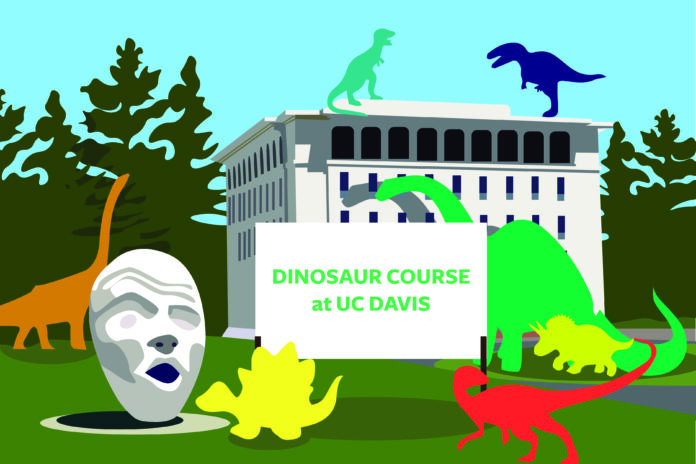Many non-STEM major students choose to take GEL 012 as a GE for science and engineering credit
Tyrannosaurus rex, Velociraptor, Iguanodon, Brachiosaurus, Allosaurus, Stegosaurus — all names of dinosaurs that students learn about in GEL 12: Dinosaurs. The two-unit class grants students science and engineering general education credit, making it a popular choice for non-STEM majors.
According to Sandy Carlson, a professor in the department of earth and planetary sciences who teaches GEL 12 every Winter Quarter, the class aims to introduce lower division students to a variety of different concepts in evolution and paleobiology, using dinosaurs as examples. The class is especially geared toward students without a strong science background.
“I took [GEL 12] because everyone at a young age loves dinosaurs and goes through that phase,” said first-year English major Cami Nembach. “And with the ‘Jurassic Park’ movies, you just have a soft place in your heart for dinosaurs.”
The class meets twice a week for a 50-minute lecture. According to Nembach, each lecture starts off with the professor showing the class a current event article involving dinosaurs. New information is always being discovered about dinosaurs, and the professor makes connections between these events to the theme of the class that day. Then she moves on through the rest of the lecture.
Usually every quarter, the class is almost full with around 250 students. The class was first taught around 27 years ago and has changed from being offered once a year to being offered every quarter due to the high demand, according to Carlson.
Carlson says one goal of the class is to gain a better understanding of past worlds and extinct animals. Understanding this will help students better appreciate the world they live in today and have a deeper understanding of how science, the scientific method and hypothesis testing work.
“You see [dinosaur] characteristics in animals that are around today,” Nembach said. “It’s crazy to wrap your head around these animals that were so much bigger than us.”
A goal of the class is for students to be able to understand and be critical of scientific reports. This is often a new concept for those who are non-STEM majors.
“The scientific reports that you see are sometimes exaggerated or misleading in some ways,” Carlson said. “And developing the critical skills to detect what’s false, I think that’s really important as well. I think in college, it’s appropriate to start questioning.”
The workload of the class mostly involves studying for the midterm and the final exam since there is no homework. Reading from the textbook is recommended but optional, according to Carlson.
“We set it up so it would not be hugely burdensome,” Carlson said. “I think it’s really important for people to come to class, so I think that’s part of the workload. There’s a textbook that’s recommended but not required, but I think it’s good for a lower division class to have some kind of backup for people, especially for people who are not science majors.”
Carlson believes that the course is so popular because it is fun, and people in general are interested in dinosaurs.
“I think the whole dinosaur-bird connection is really compelling because it makes people think about the nature of evolution and how we live with birds today and they are related to these many large, terrestrial dinosaurs,” Carlson said. “Terrestrial dinosaurs are extinct, so it just makes people wonder about them. So what we try to do in the class is to try to put that wonder into a scientific class, to set up hypotheses and test them.”
According to Nembach, she likes GEL 12 because it is a relaxing class and the professor is very animated and involved.
“She’s really into the topic so it helps the students get more interested in the subject,” Nembach said. “If we know that she loves it, I’m having a fun time.”
Carlson attested to her love for this class.
“Here, the subject matter is also so much fun that it really does make it fun to teach,” Carlson said.
First-year cellular biology major Kacey Zimmerman said that she took the class not for Science and Engineering GE credit, since she is a science major, but because she wanted to have a little more units than just her main classes. In addition to her really difficult STEM classes, she wanted one interesting, easy and fun class.
“There’s not a lot of outside work, which I think is a good thing for a GE because for me personally, even though [GEL 12] does not give me GE credit, when I’m taking a GE class, I want to learn new things that aren’t really included in what I would learn about and I want to spend most of my energy on classes that do pertain to my major,” Zimmerman said.
According to Nembach, she recommends the class to students who like dinosaurs, even if they are not very involved in science. Zimmerman shared her sentiments.
“I would recommend it even if you aren’t very sciencey,’” Zimmerman said. “It’s pretty easy to go in and get this information. You don’t really need much background knowledge.”
Written By: MARGO ROSENBAUM — features@theaggie.org




